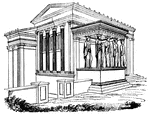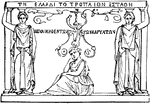Caryatids

Caryatic Order
An order of architecture wherein the entablature is supported by female figures clothed in long garments,…
Greek Caryatid
The Greek Caryatid is a female figure used as a support in place of a column. It is found in the temple…

Modern Caryatid
The modern caryatid is two female figures side by side used as supports in place of columns.

Modern Caryatid
The modern caryatid is two female figures side by side used as supports in place of columns.

Modern Caryatid
The modern caryatid is two female figures side by side used as supports in place of columns.
Modern Caryatid
The modern caryatid is two female figures side by side used as supports in place of columns.
Modern Caryatid
The modern caryatid is two female figures side by side used as supports in place of columns.

Caryatides
"Caryae was a city in Arcadia, near the Laconian border, the inhabitants of which joined the Persians…
Caryatis from the Erechtheum at Athens
Caryatides are a blending of architecture and sculpture, but they are not of frequent occurrence. These…
Profile of the Caryatis with Pedestal and Entablature
Caryatides are a blending of architecture and sculpture, but they are not of frequent occurrence. These…

